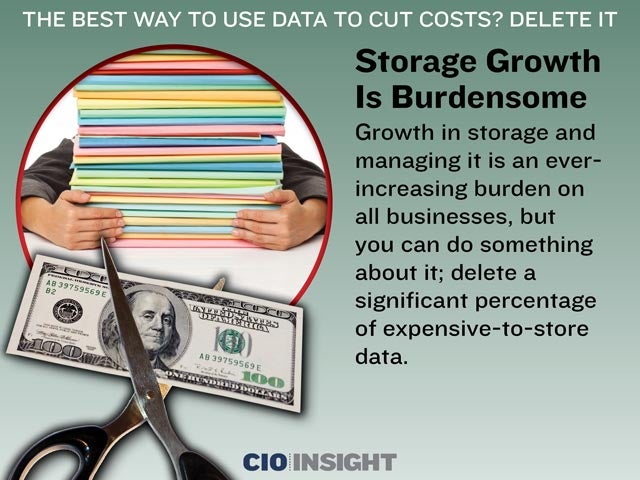
The Best Way to Use Data to Cut Costs? Delete It
 The Best Way to Use Data to Cut Costs? Delete It
The Best Way to Use Data to Cut Costs? Delete It
While much is made of data analytics and the troves of data organizations retain, collecting and indiscriminately storing data can be detrimental to the business.
 Total Cost of Data Storage
Total Cost of Data Storage
The total cost of ownership for storage is not declining. If a hypothetical company stores one petabyte of data now, it is likely to store 1.45 PB next year. If the storage cost drops 15% or 30% while volume grows 40%, storage cost cannot decline.
 Storage Growth Is Burdensome
Storage Growth Is Burdensome
Growth in storage and managing it is an ever-increasing burden on all businesses, but you can do something about it; delete a significant percentage of expensive-to-store data.
 Data Hoarding
Data Hoarding
Not all data is useful. Businesses often don’t know what data they possess. Much of it may be junk that wastes data analysts’ time.
 Big Data Hype
Big Data Hype
One reason businesses collect and store more data than they can process is the vague belief that more is better. They hope to gain new insight from their data, but this is not a business strategy. It is a business wish.
 Fear of Legal Consequences
Fear of Legal Consequences
Regulations, such as the U.S. Securities and Exchange Commission, encourage data hoarding because companies believe it is safer to keep everything. There is no obvious incentive to delete, and under-preserving creates risks.
 U.S. Courts Encourage Data Storage
U.S. Courts Encourage Data Storage
In litigation, U.S. courts instruct juries to look askance at the absence of relevant data, such as emails, encouraging businesses to store everything.
 European Union Deletion Policies
European Union Deletion Policies
The EU, recognizing “unreasonable persistence of data” in employee performance, for example, said data retention should be limited to 2 to 3 years after an evaluation.
 Losing Junk Data Requires Information Governance
Losing Junk Data Requires Information Governance
Junk data and its drain on a company’s resources are not an IT problem. They are a business problem.
 Cooperation Is Key
Cooperation Is Key
To attack junk data, businesses must take a holistic view of the challenge. The CIO and CFO and the company’s legal, compliance and security departments must collaborate to determine what data to store and what to delete.
 Develop Statistical Sampling Protocols
Develop Statistical Sampling Protocols
Statistical sampling protocols can help reduce large amounts of storage media. Indexing and machine analysis can pinpoint what data to preserve or delete.
 Automate Data Deletion
Automate Data Deletion
Manual deletion is difficult and expensive, so automate it. Establish machine rules that mandate the deletion of unnecessary and vulnerable duplicates.
 Return on Investment
Return on Investment
Good information governance resulted in $8 million in savings for metals and mining company Rio Tinto, when it eliminated 35% of file shares in its network, for example.